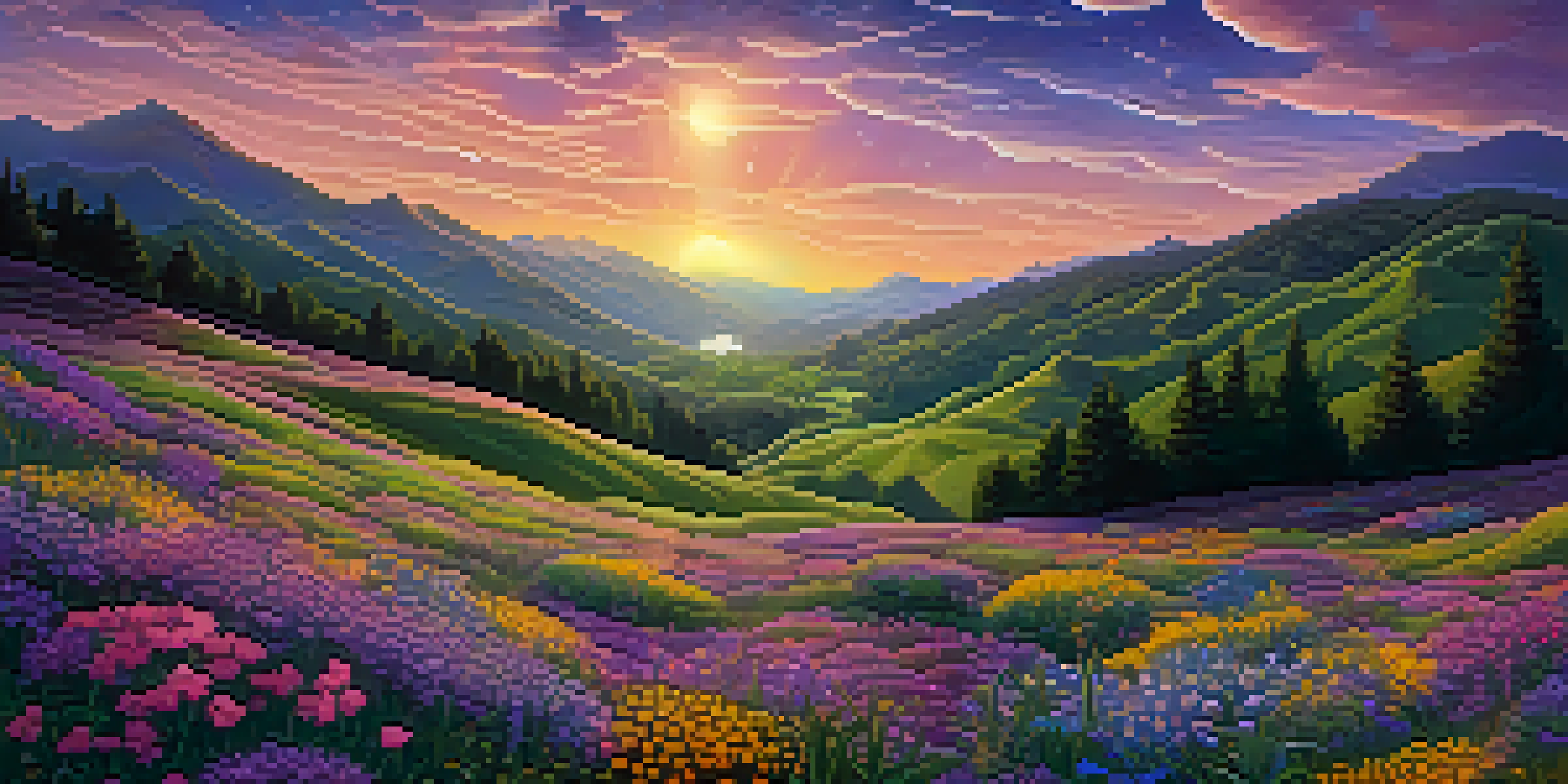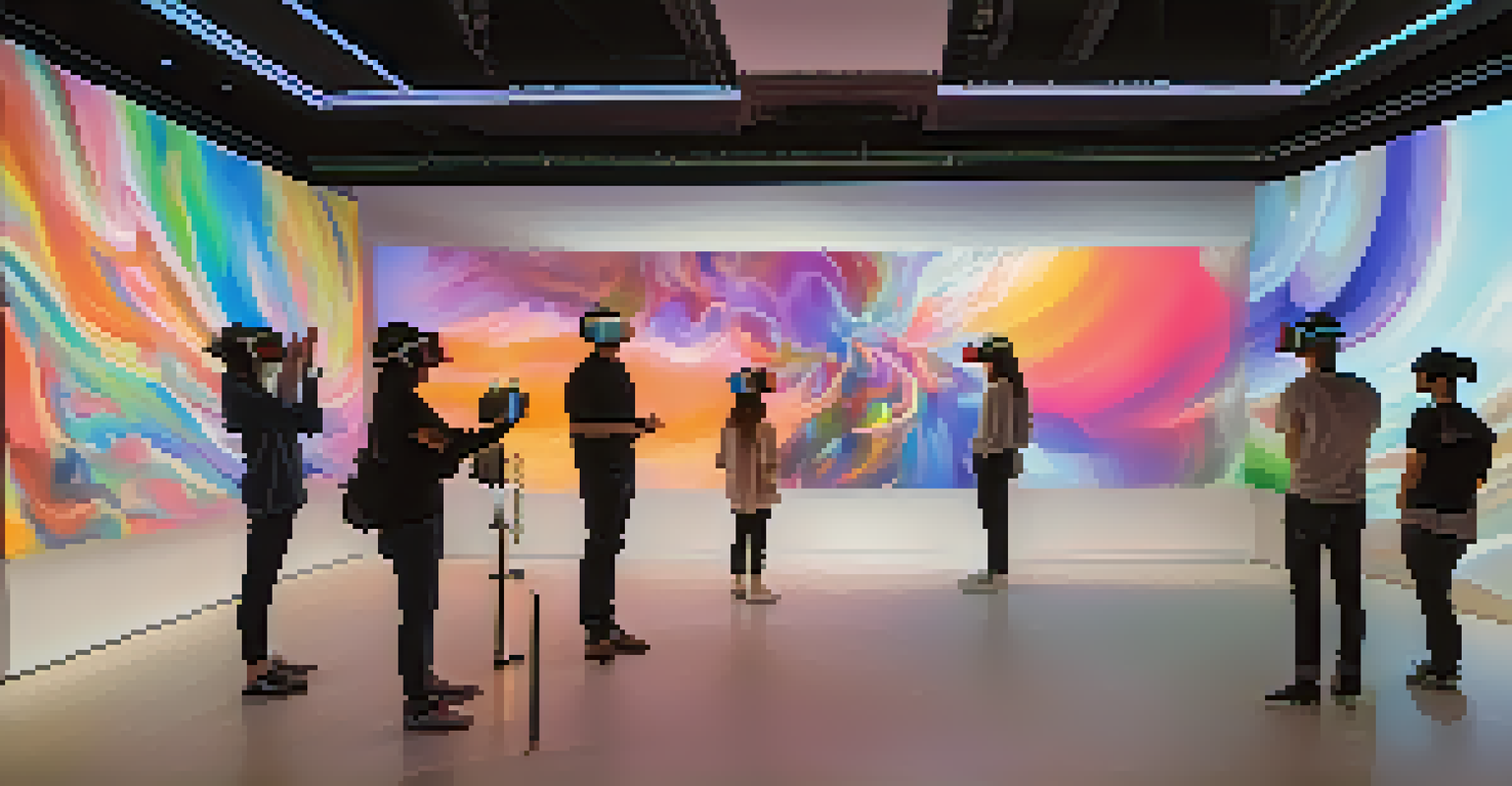The Intersection of Algorithms and Artistic Creativity in Painting

Understanding Algorithms in Art Creation
At first glance, algorithms might seem like dry formulas, but they can be vibrant tools in the world of art. An algorithm is essentially a step-by-step procedure or formula for solving a problem, and in painting, it helps artists explore new creative avenues. By manipulating data and using computational techniques, artists can produce stunning visuals that blend logic with creativity.
Art is not freedom from discipline, but disciplined freedom.
For instance, consider the use of fractals in painting. These intricate patterns emerge from simple mathematical equations and can create mesmerizing landscapes or abstract designs. Artists like Jon McCormack have used algorithms to generate unique artworks that challenge traditional notions of creativity, inviting viewers to see art through a mathematical lens.
Thus, understanding how algorithms work can empower artists to push boundaries, merging technology with their artistic vision. This intersection opens up a dialogue between the analytical and the emotional, allowing for a richer appreciation of both art forms.
The Role of Generative Art in Painting
Generative art takes the concept of algorithms even further, allowing artists to create works that evolve through computational processes. This form of art is not just about the final piece; it's about the journey and the rules that govern the creation. Artists set parameters and let the algorithm generate variations, leading to unexpected and often delightful results.

A great example is the work of Casey Reas, co-creator of Processing, a programming language for visual arts. His pieces often demonstrate how algorithms can produce artworks that feel organic and alive, despite being rooted in code. This unpredictability mirrors the creative process, where inspiration can arise from serendipity.
Algorithms Enhance Artistic Creativity
By using algorithms, artists can explore new creative avenues and generate unique artworks that blend logic with imagination.
By embracing generative art, painters can experience a blend of control and chaos, creating a dynamic relationship between the artist and the artwork. The algorithm acts as both a tool and a collaborator, fostering a new kind of creativity that challenges the artist's role.
Algorithms as Tools for Inspiration
One of the most intriguing aspects of algorithms in painting is their ability to serve as a source of inspiration. Artists can use algorithms to explore patterns, colors, and compositions that they might not have considered otherwise. For instance, by using AI to analyze color palettes from famous paintings, artists can generate new ideas that draw from art history while remaining fresh and contemporary.
The best way to predict the future is to create it.
This process is akin to a chef experimenting with unexpected ingredients to create a unique dish. Just as a chef may find inspiration in a new flavor combination, artists can discover novel compositions or color schemes through algorithmic exploration. It’s a way to blend the old with the new, honoring traditional techniques while welcoming innovation.
As algorithms continue to evolve, they offer artists a treasure trove of possibilities. By integrating these tools, painters can cultivate a rich environment for creativity, one where inspiration is always at their fingertips.
The Debate: Authenticity in Algorithmic Art
With the rise of algorithmic art comes a compelling debate about authenticity. Some critics argue that if an artwork is produced by an algorithm, it lacks the personal touch of human creativity. They may ask whether a painting created with the help of code can be considered 'true' art or merely a product of technology.
However, one could argue that every artist uses tools to express their vision, whether it’s a paintbrush, a camera, or a computer. Just as the invention of photography did not diminish painting, the use of algorithms can enhance an artist's ability to convey ideas. In fact, many artists see algorithms as an extension of their creative process, much like the palette they choose.
Generative Art Merges Control and Chaos
Generative art allows artists to set parameters for algorithms, resulting in unexpected and dynamic artworks that reflect the creative process.
Ultimately, the question of authenticity may depend on the artist's intent and how they integrate technology into their work. Embracing algorithms does not erase creativity; rather, it amplifies it, allowing for new forms of expression that can resonate deeply with audiences.
The Impact of AI on Artistic Styles
Artificial intelligence (AI) is transforming the landscape of painting by introducing new styles and methods of creation. AI can analyze vast databases of artistic styles, enabling it to generate paintings that mimic the techniques of renowned artists. This fusion of technology and art creates exciting opportunities for both established and emerging artists.
For example, artists can use AI algorithms to create hybrid styles, blending elements from various movements like impressionism and abstract expressionism. This kind of experimentation can produce artworks that are not only visually striking but also provoke thought about the nature of creativity and the role of technology in art-making.
As AI continues to develop, the potential for new artistic styles is limitless. It invites artists to rethink their creative processes and explore uncharted territories, ultimately enriching the art world with diverse expressions.
Collaboration Between Artists and Algorithms
Collaboration is key in the intersection of algorithms and artistic creativity. Many artists are now partnering with programmers and data scientists to push the limits of what can be created. This teamwork allows for a seamless blending of artistic intuition and technical expertise, resulting in innovative artworks that neither could achieve alone.
One notable example is the work of Sougwen Chung, who collaborates with AI to create intricate drawings that combine her hand-drawn elements with algorithm-generated designs. This interplay highlights the potential for a harmonious relationship between human creativity and machine learning, showcasing the beauty that can arise from their collaboration.
AI Transforms Artistic Styles
Artificial intelligence enables artists to combine various artistic movements, leading to innovative styles and enriching the art landscape.
Through these partnerships, artists gain access to new tools and methodologies that enhance their creative capabilities. As this trend continues, we may see a new era of art that celebrates collaboration, pushing the boundaries of both technology and artistic expression.
The Future of Algorithms in Artistic Painting
Looking ahead, the future of algorithms in artistic painting is brimming with possibilities. As technology advances, we can expect to see even more sophisticated algorithms that can learn from an artist’s style and preferences. This could lead to personalized art generation tools that adapt to individual tastes, making art more accessible and engaging.
Moreover, the integration of virtual reality (VR) and augmented reality (AR) with algorithmic art could create immersive experiences for viewers. Imagine stepping into a virtual gallery where paintings change and evolve based on your interactions, providing a unique, tailored experience each time.

As we embrace these advancements, artists will continue to find new ways to express their creativity while engaging with audiences in innovative ways. The intersection of algorithms and artistic creativity is not just a trend; it's a glimpse into the vibrant future of painting.